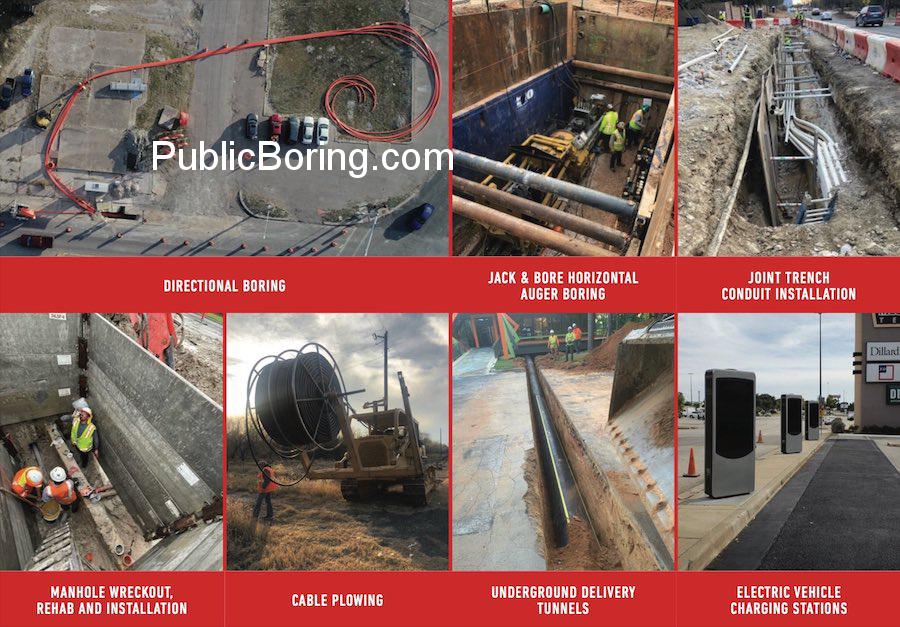Boring Conduit: A Comprehensive Process and Service Description
Boring conduits refer to the trenchless method of installing protective tubes (conduits) underground which can house utilities like electrical wires, fiber optic cables, or water lines. Given its minimally invasive approach, it’s become a preferred method in urban and sensitive environments. Here’s a detailed description of the process and the services involved:
- Initial Assessment:
- Consultation with Experts: A conduit boring project starts with consulting experts who can assess the feasibility and requirements of the project. These experts usually hail from companies or corporations that specialize in boring conduits.
- Site Development: This involves a thorough evaluation of the construction site, identifying potential obstacles, assessing soil conditions, and planning the boring path. This ensures that the boring process is efficient and meets the project’s goals.
- Equipment Selection:
-
- Auger Boring with ASAP Auger: Depending on the boreable medium and project scale, tools like the ASAP Auger might be selected for the boring process.
- Cable Plow & Cable Plowing: For projects that require the direct installation of cables, a cable plow might be used. This tool can lay cables without extensive excavation, making the process faster and more efficient.
- The Boring Process:
-
- Starting the Bore: The auger, positioned horizontally, initiates the boring process.
- Dry vs. Wet Boring: Based on soil type and groundwater presence, either a dry or slurry (wet) boring method might be employed. Slurry boring utilizes a fluid mixture to facilitate the boring process in challenging conditions.
- Slick Bores: In some cases, a smooth and continuous bore is required, especially for sensitive utilities. Slick bores are made to ensure minimal friction during utility installation.
- Hard Rock Boring: In regions with challenging rocky terrain, specialized equipment and techniques are used to bore through the hard rock.
- Conduit Installation:
-
- Conduit Placement: After creating the bore, conduits are installed. These provide protection for utilities like electrical wires, fiber optic cables, or even water lines.
- Ductbank Installation: Some projects require the placement of multiple conduits in parallel arrangements, often encased in concrete. Ductbank work ensures an organized and efficient setup for various utilities.
- Pulling: Once the conduits are in place, utilities are “pulled” through them. This might involve electrical wires, fiber cables, or other infrastructure elements.
- Utility Services:
-
- Fiber Boring: Specialized boring might be done to install fiber optics for services like FTTB (Fiber to the Building), FTTH (Fiber to the Home), FTTCS (Fiber to the Curb/Cell Site), and FTTT (Fiber to the Tower).
- Electric Vehicle Infrastructure: For modern urban development, infrastructure for electric vehicle charging stations might be installed. This includes the EV charger components and the associated electrical connections.
- Small Cell Installation: For telecommunication enhancement, small cells are installed using the conduits to enhance signal coverage and strength.
- Finalization:
-
- Landscape Rehabilitation: Post-construction, the landscape is restored, ensuring minimal environmental disruption.
- Manhole Services: Manholes provide access points for various utilities. Services include wreckout installation, rehabilitation, and precise placement for utility access.
- Collaborations and Partnerships:
-
- Government and Military Projects: Boring conduit companies might collaborate with government bodies or undertake specialized military projects.
- Co-ops and Local LLCs: Collaboration with local co-ops and LLCs can facilitate community-specific projects.
- Subcontracting: For multi-faceted projects, subcontractors might be involved to handle specialized tasks or aspects.
- Emergency Services:
-
- Rescue and Repair: Should there be unexpected issues or emergencies, the company is equipped with the necessary tools and expertise to provide immediate solutions.
Boring conduits have revolutionized underground construction, offering efficient, less disruptive methods to install critical infrastructure. Whether it’s enhancing smart city developments, installing renewable energy utilities, or expanding telecommunication networks, boring conduit companies play a crucial role in modern infrastructure development.


